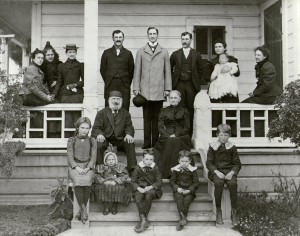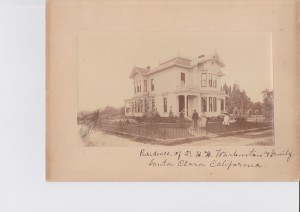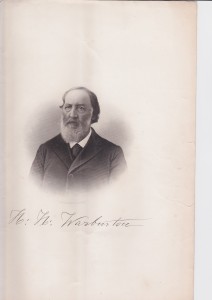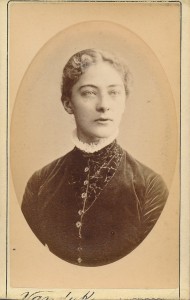I put the following picture in the Photo Gallery in February 2014. It shows Henry Hulme Warburton and his wife Catherine sitting in the centre with their three sons behind, and various other family members. It was sent to me by Peter Warburton, a descendant of Henry’s brother Edmund.

The following picture shows their home. It was sent to me by David Hartland, who is descended from John’s son James Pennington Warburton. David has done much research on the doctors of Betley and provided me with lots of information, which he hopes to publish himself some day.
Henry Hulme Warburton, M. D. was born in Betley, Staffordshire in 1819. He was educated at Giggleswick, Yorkshire, England, and trained as a doctor at the London Hospital Medical Institute, and then practised with his father until 1844, when he emigrated to America.
He practised a while in NewYork but in the autumn of 1845, he went to New London, Connecticut, and embarked as a surgeon in the whaling vessel Corea, under Capt. Benjamin Hemstead. His voyages took him to the northwest coast of North America, the coast of New Zealand, and the Sandwich Islands. In 1847, at San Francisco, he resigned his commission and tried his hand at gold prospecting before settling in Santa Clara in 1848. Here he established his practice, one of only three in the whole of California at that time. He continued to practice for the rest of his life.
He married Mrs. Catherine Pennel, nee Long, a daughter of Peter and Hilah Long in 1855, and had seven children, two of which died in infancy. He visited friends and relatives in England in 1870, and died in 1903, aged 83. The following picture of Henry was also sent by David Hartland.
Henry and his family were significant figures in Santa Clara. Warburton Avenue was named after Henry. His grandson, Austen Den Warburton (1917-1995) was a lawyer and significant local historian who had a park named after him.
Searching the web I found a history of Santa Clara which includes a picture of Warburton’s Pharmacy which Henry established in 1860. The picture was taken in 1906, three days before it burnt down. There is also a picture of Henry’s office which was subsequently moved to Historic Park in San Jose.
More recently I was sent the following photograph by Tony Parry. It is of the beautiful and accomplished Miss Selina Pennington Warburton born 1861 in Woore, Staffordshire. The photograph is dated 23 August 1883, in Liverpool.
Selina was the niece of Henry Hulme Warburton, being the eldest daughter of his brother Charles Wesley Warburton. Charles was also a doctor. In 1891 she married Dr Frank Parry who may have been apprenticed to Charles. She died childless on August 4th 1912, during an operation for appendicitis. Selina had a sister who had been “shot in the head” but apparently survived, since she went round commenting on the fact.
Frank subsequently remarried and had a family which includes Tony who sent the picture.
The following picture is of Henry Hulme’s father John, sent to me by David Hartland.

Dr John Warburton of Betley, Staffs was the father of Henry Hulme Warburton. He was sued in 1819 for praising as an apothecary without a license.
John was born in 1792 the eldest son of Arnold Warburton and Anne Hulme. The photograph was taken when he was about 70 years old. He died in his 86th year.
In all John had two wives and 16 children, all but 3 reaching adulthood. Henry was the eldest son to reach maturity. John was part of an extensive medical family. His brother-in-law and two nephews, six of his own sons, and three grandsons all became doctors. In addition one daughter and two granddaughters (including Selina) married doctors. The only son who didn’t become a doctor became a lawyer.
Arnold was born into a farming family in Dunham, a township in Bowdon parish, so in two generations the family progressed from farmers to doctors. A clue as to how this was achieved can be found in an article from the Morning Chronicle of November 4th 1819, the year when Henry was born.
The article, entitled EMPIRICISM, describes an action to recover penalties of £20 against John Warburton for practicing as an apothecary in the town of Macclesfield when not duly qualified to do so.
A trial had taken place the previous spring before the Honourable Baron Garrow at Staffordshire Assizes. This was Sir William Garrow who made his name as an advocate of the adversarial court system, and who is credited with introducing the phrase “innocent until proven guilty”. He is known to British TV viewers from the BBC series Garrow’s Law which is based on his early life as a barrister. After a period in parliament he was, by 1819 an Assize Judge.
John Warburton had claimed the Judge had misdirected the jury and requested a new trial. The article is based on the report of the Appeal Judge’s which was read out by Mr Justice Best, and which rejected the appeal.
The background to the trial was an Act of Parliament passed in 1815 which required those practising as an Apothecary to be suitably qualified. The Act included an exemption for anyone who was already practising before August 1st 1815. John’s defence was that this was the case and it was shown that he had indeed prescribed remedies to various patients but the Judge’s summing up had declared that “everyone who practised physic, by running about the country as a quack and empiric” was not entitled to exemption, and the Jury had to decide if John had practised in accordance with the Act’s definition of an Apothecary, the main element being able to make up the prescriptions of others.
Much of the report was centred on the evidence of John’s father Arnold and this gives a fascinating insight into the history of the family. Arnold stated he had followed the practise of medicine for 15 years. During cross-examination he was very reluctant to admit his profession prior to that but eventually admitted he had been a farmer, and was the son and grandson of farmers. Fifteen years before the trial, in 1804, Arnold was 37 years old.
Arnold had initially practised in Dunham, and then Stockport before moving to Macclesfield in 1811. In Stockport he had taken his son John into the business. John had originally tried weaving as an occupation, and spent a few weeks in two different factories, but he didn’t like it. He then joined his father is his business whilst he was practising in Stockport, and had now been with him for about 10 years. He attended his father’s patients, administered to them, and took payment.
When in February 1815 Arnold moved again to Newcastle-under-Lyme, he left John to continue his practise in Macclesfield, but later that year had had to call him to help him in Newcastle.
At the time of the trial Arnold had three surviving children, a son and two daughters, and was married to his second wife. His wife had moved with him to Newcastle, while the daughters stayed in Macclesfield with John, until they also moved to Newcastle. John was a principal in his father’s business at Newcastle for over 12 months until he married the daughter of Reverend Pennington and moved to Betley. Arnold then took an apprentice, Master Hayes, who married his daughter Ellen (also known as Elizabeth) in1817.
Arnold’s first wife was Anne Hulme and they had three girls and three boys. When Anne died Arnold remarried in 1812 to Mary Windless.
Arnold was closely cross-examined. He described himself as a surgeon but proved unable to spell the word. He had learned from his brother-in-law, Dr Hulme who “practised the same as the Whitworth doctors who were regular physicians”. However when asked where the doctors got their degrees, Arnold said they had no degrees and were not physicians, only doctors who doctored cows and other things, and sometimes humans, as had Arnold.
The reference to the Whitworth doctors is probably a reference to the Taylor family who practised in Whitworth, near Rochdale from the 1750s to the 1870s. The first of the family to practise was John Taylor, a blacksmith who gained a reputation for treating animal fractures. It is said that his reputation began when built a tin case to heal a cat’s broken leg. The family later began to treat humans, gaining widespread reputation as bone-setters. They were also famous for their treatment of cancers using an ointment called ‘keen’. A liquid known as ‘Whitworth red bottle’ was applied to sprains and bruises. By the late eighteenth century, vast numbers of people were coming to Whitworth to be treated.
In all 18 members of the family practised as doctors, but although they gained a almost mythical reputation, only the later ones were formally trained, and they were considered quacks in some circles.
At John’s trial poor Arnold was forced to admit that he couldn’t make up a medicine from a doctor’s prescription, and although he was aware there were 16 ounces in a pound he did not go by regular weight, but mixed his medicines by hand. Although he bled patients with a lancet he could not name particular arteries.
John’s defence was that he had practised as an Apothecary before August 1st 1815, and his level of skill was irrelevant. However Baron Garrow directed the jury that by the terms of the Act an Apothecary should be able to make up a prescription and the Jury had to decide whether there was any opportunity for John to have learned this skill. He declared that “if it could be shown that John had even been a footman to an Apothecary and afterwards practised before the appointed time he would have taken him to have acquired a knowledge of his profession”. However his only source of learning was his father, “a man more ignorant than the most ignorant that they had ever before examined in any Court”.
The Appeal Judges agreed that Baron Garrow had been correct in so directing the Jury, and so refused the appeal. Mr Justice Bayley had referred to Arnold as a “cow-doctor and a horse-doctor. It was true that such a doctor might administer medicine to biped patients; but his Lordship thought in such a case, the applications of such persons for relief would fairly entitle the defendant to,the additional degree of ass-doctor”. This statement produced general laughter in the Court.
Thus a medical dynasty was founded from very inauspicious beginnings. John acquired a proper medical training. In censuses he is careful to identify himself as a Licentiate of the Apothecary Company, who studied at the London Hospital, in addition to his occupation of Surgeon, or General Practitioner. His sons were also properly trained.
It is difficult to assess how effective Arnold’s ministrations were. He seems to have begun with animals, and maybe like the Taylor’s in Whitworth, he had sufficient success to attract human patients. He was also clearly influenced by, and learned from his father-in-law who had a similar practice. It is tempting to think his frequent relocation of his practise was to leave behind unfavourable reactions, but the fact he left John to run his Macclesfield practice, until he quickly needed his help in the new Newcastle-under-Lyme practice suggests he was able attract a fair amount of trade, and he did not leave too much of a mess in Macclesfield.
Arnold only lived three years after the trial so it is unlikely he changed his ways. But it is clear that from the census entries that the trial had a major effect on John. At that time he had already started his practice in Betley, where he remained for the rest of his life.
The full article from the November 19thn edition of the Morning Chronicle can be obtained from The British Newspaper Archive (subscription required)
![]()



Thank you for this. My great great grandmother was Esther Warburton, first cousin to the betley Warburtons, and she married a doctor too, but by a slightly different route: she was 20 when she married my gt gt grandfather Dr Henry Gent of Knutsford, then aged 52. Their daughter was born two months later. Esther had nursed Henry’s elderly mother, and upon her death had become Henry’s servant.